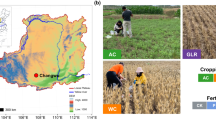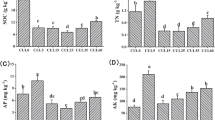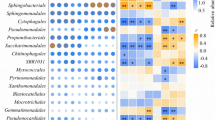Abstract
Aims
Crop rotation plays an important role in changing soil microbial communities, which is critical to maintaining soil multifunctionality. However, limited data exist on the long term impact of crop rotations on soil multifunctionality and its link with soil fungal community in drylands.
Methods
In a dryland field experiment with 30-year legume- and non-legume-based winter wheat rotations and winter wheat-fallow system, we investigated the soil multifunctionality (via cycling and pools of soil carbon and nitrogen) and the overall community and functional groups of soil fungi. The links between soil multifunctionality and fungal communities were also explored.
Results
We found that long-term crop rotation increased soil multifunctionality index and that of carbon cycle. Crop rotation shifted soil fungal community composition, and reduced the proportion of putative pathotrophs. The overall fungal community was almost equally explained by soil and plant variables, while fungal functional groups (i.e., saprotrophs and pathotrophs) were more affected by soil variables. The indicator taxa in the non-legume-winter wheat rotation were distinctly different from those in the legume-based winter wheat rotation soils, indicating that the non-legume-winter wheat rotation selects different fungal taxa from the legume-based winter wheat rotation. Moreover, the changes in community composition of soil fungi, putative saprotrophs and pathotrophs were related to soil multifunctionality and that of carbon and nitrogen cycles.
Conclusions
Our results highlight that long-term crop rotations shape the soil fungal communities; the changes in soil fungi and fungal functional groups have potential to improve soil multifunctionality in the crop rotation systems in drylands.




Similar content being viewed by others
References
Ai C, Zhang S, Zhang X, Guo D, Zhou W, Huang S (2018) Distinct responses of soil bacterial and fungal communities to changes in fertilization regime and crop rotation. Geoderma 319:156–166. https://doi.org/10.1016/j.geoderma.2018.01.010
Arihara J, Karasawa T (2000) Effect of previous crops on arbuscular mycorrhizal formation and growth of succeeding maize. Soil Sci Plant Nutr 46:43–51. https://doi.org/10.1080/00380768.2000.10408760
Berry D, Schwab C, Milinovich G, Reichert J, Ben Mahfoudh K, Decker T, Engel M, Hai B, Hainzl E, Heider S, Kenner L, Müller M, Rauch I, Strobl B, Wagner M, Schleper C, Urich T, Loy A (2012) Phylotype-level 16S rRNA analysis reveals new bacterial indicators of health state in acute murine colitis. ISME J 6:2091–2106. https://doi.org/10.1038/ismej.2012.39
Coleman JJ (2016) The Fusarium solani species complex: ubiquitous pathogens of agricultural importance. Mol Plant Pathol 17:146–158. https://doi.org/10.1111/mpp.12289
De Cáceres M, Legendre P (2009) Associations between species and groups of sites: indices and statistical inference. Ecology 90:3566–3574
Delgado-Baquerizo M, Maestre FT, Gallardo A, Bowker MA, Wallenstein MD, Quero JL, Ochoa V, Gozalo B, García-Gómez M, Soliveres S, García-Palacios P, Berdugo M, Valencia E, Escolar C, Arredondo T, Barraza-Zepeda C, Bran D, Carreira JA, Chaieb M, Conceição AA, Derak M, Eldridge DJ, Escudero A, Espinosa CI, Gaitán J, Gatica MG, Gómez-González S, Guzman E, Gutiérrez JR, Florentino A, Hepper E, Hernández RM, Huber-Sannwald E, Jankju M, Liu J, Mau RL, Miriti M, Monerris J, Naseri K, Noumi Z, Polo V, Prina A, Pucheta E, Ramírez E, Ramírez-Collantes DA, Romão R, Tighe M, Torres D, Torres-Díaz C, Ungar ED, Val J, Wamiti W, Wang D, Zaady E (2013) Decoupling of soil nutrient cycles as a function of aridity in global drylands. Nature 502:672–676. https://doi.org/10.1038/nature12670
Delgado-Baquerizo M, Maestre FT, Reich PB, Jeffries TC, Gaitan JJ, Encinar D, Berdugo M, Campbell CD, Singh BK (2016) Microbial diversity drives multifunctionality in terrestrial ecosystems. Nat Commun 7:10541. https://doi.org/10.1038/ncomms10541
Dexter E, Rollwagen-Bollens G, Bollens SM (2018) The trouble with stress: a flexible method for the evaluation of nonmetric multidimensional scaling. Limnol Oceanogr: Methods 16:434–443. https://doi.org/10.1002/lom3.10257
Edgar RC (2013) UPARSE: highly accurate OTU sequences from microbial amplicon reads. Nat Methods 10:996–998. https://doi.org/10.1038/nmeth.2604
Edgar RC, Haas BJ, Clemente JC, Quince C, Knight R (2011) UCHIME improves sensitivity and speed of chimera detection. Bioinformatics 27:2194–2200. https://doi.org/10.1093/bioinformatics/btr381
Garg N, Chandel S (2010) Arbuscular mycorrhizal networks: process and functions A Review. Agron Sustain Dev 30:581–599
Gattinger A, Muller A, Haeni M, Skinner C, Fliessbach A, Buchmann N, Mäder P, Stolze M, Smith P, Scialabba NE, Niggli U (2012) Enhanced top soil carbon stocks under organic farming. Proc Natl Acad Sci U S A 109:18226–18231
Gil SV, Meriles JM, Haro R, Casini C, March G (2008) Crop rotation and tillage systems as a proactive strategy in the control of peanut fungal soilborne diseases. Biocontrol 53:685–698. https://doi.org/10.1007/s10526-007-9105-1
Guo SL, Wu JS, Dang TH (2008) Effects of crop rotation and fertilization on aboveground biomass and soil organic C in semi-arid region. Sci Agric Sin 41:744–751
Hu W, Ran J, Dong L, Du Q, Ji M, Yao S, Sun Y, Gong C, Hou Q, Gong H, Chen R, Lu J, Xie S, Wang Z, Huang H, Li X, Xiong J, Xia R, Wei M, Zhao D, Zhang Y, Li J, Yang H, Wang X, Deng Y, Sun Y, Li H, Zhang L, Chu Q, Li X, Aqeel M, Manan A, Akram MA, Liu X, Li R, Li F, Hou C, Liu J, He JS, An L, Bardgett RD, Schmid B, Deng J (2021) Aridity-driven shift in biodiversity-soil multifunctionality relationships. Nat Commun 12:5350. https://doi.org/10.1038/s41467-021-25641-0
Huang J, Yu H, Guan X, Wang G, Guo R (2016) Accelerated dryland expansion under climate change. Nat Clim Change 6:166–171. https://doi.org/10.1038/nclimate2837
Lauber CL, Strickland MS, Bradford MA, Fierer N (2008) The influence of soil properties on the structure of bacterial and fungal communities across land-use types. Soil Biol Biochem 40:2407–2415. https://doi.org/10.1016/j.soilbio.2008.05.021
Li J, Liu G, Chen M, Li Z, Qu Y (2013) Cellodextrin transporters play important roles in cellulase induction in the cellulolytic fungus penicillium oxalicum. Appl Microbiol Biotechnol 97:10479–10488
Li Q, Zhang D, Zhang J, Zhou Z, Pan Y, Yang Z, Zhu J, Liu Y, Zhang L (2023) Crop rotations increased soil ecosystem multifunctionality by improving keystone taxa and soil properties in potatoes. Front Microbiol 14:1034761. https://doi.org/10.3389/fmicb.2023.1034761
Maestre FT, Quero JL, Gotelli NJ, Escudero A, Ochoa V, Delgado-Baquerizo M, García-Gómez M, Bowker MA, Soliveres S, Escolar C, García-Palacios P, Berdugo M, Valencia E, Gozalo B, Gallardo A, Aguilera L, Arredondo T, Blones J, Boeken B, Bran D, Conceição AA, Cabrera O, Chaieb M, Derak M, Eldridge DJ, Espinosa CI, Florentino A, Gaitán J, Gatica MG, Ghiloufi W, Gómez-González S, Gutiérrez JR, Hernández RM, Huang X, Huber-Sannwald E, Jankju M, Miriti M, Monerris J, Mau RL, Morici E, Naseri K, Ospina A, Polo V, Prina A, Pucheta E, Ramírez-Collantes DA, Romão R, Tighe M, Torres-Díaz C, Val J, Veiga JP, Wang D, Zaady E (2012) Plant species richness and ecosystem multifunctionality in global drylands. Science 335:214–218. https://doi.org/10.1126/science.1215442
McDaniel MD, Tiemann LK, Grandy AS (2014) Does agricultural crop diversity enhance soil microbial biomass and organic matter dynamics? A meta-analysis. Ecol Appl 24:560–570. https://doi.org/10.1890/13-0616.1
Michielse CB, Rep M (2009) Pathogen profile update: Fusarium oxysporum. Mol Plant Pathol 10:311–324. https://doi.org/10.1111/j.1364-3703.2009.00538.x
Nazaries L, Sarker R, Fang Y, Klein M, Singh BK (2021) The response of soil multi-functionality to agricultural management practices can be predicted by key soil abiotic and biotic properties. Agr Ecosyst Environ 307:107206. https://doi.org/10.1016/j.agee.2020.107206
Nguyen NH, Song Z, Bates ST, Branco S, Tedersoo L, Menke J, Schilling JS, Kennedy PG (2016) FUNGuild: An open annotation tool for parsing fungal community datasets by ecological guild. Fungal Ecol 20:241–248. https://doi.org/10.1016/j.funeco.2015.06.006
Nuruzzaman M, Lambers H, Bolland MDA, Veneklaas EJ (2005) Phosphorus benefits of different legume crops to subsequent wheat grown in different soils of Western Australia. Plant Soil 271:175–187
Olofsson J, Ericson L, Torp M, Stark S, Baxter R (2011) Carbon balance of arctic tundra under increased snow cover mediated by a plant pathogen. Nat Clim Change 1:220–223. https://doi.org/10.1038/nclimate1142
Op De Beeck M, Lievens B, Busschaert P, Declerck S, Vangronsveld J, Colpaert JV (2014) Comparison and validation of some ITS primer pairs useful for fungal metabarcoding studies. PLoS ONE 9:e97629. https://doi.org/10.1371/journal.pone.0097629
Peralta AL, Sun Y, McDaniel MD, Lennon JT (2018) Crop rotational diversity increases disease suppressive capacity of soil microbiomes. Ecosphere 9:e02235. https://doi.org/10.1002/ecs2.2235
Plaza-Bonilla D, Arrúe JL, Cantero-Martínez C, Fanlo R, Iglesias A, Álvaro-Fuentes J (2015) Carbon management in dryland agricultural systems. A Review Agron Sustain Dev 35:1319–1334. https://doi.org/10.1007/s13593-015-0326-x
Potter T, Vereecke L, Lankau R, Sanford G, Silva E, Ruark M (2022) Long-term management drives divergence in soil microbial biomass, richness, and composition among upper Midwest USA cropping systems. Agr Ecosyst Environ 325:107718. https://doi.org/10.1016/j.agee.2021.107718
Progar RA, Schowalter TD, Freitag CM, Morrell J (2000) Respiration from coarse woody debris as affected by moisture and saprotroph functional diversity in Western Oregon. Oecologia 124:426–431
Qi R, Dang T, Yang S, Ma R, Zhou L (2012) Forms of soil phosphorus and P adsorption in soils under long-term crop rotation and fertilization systems. Acta Pedol Sin 49:1136–1146
Roy J, Duijnen R, Leifheit E, Mbedi S, Temperton VM, Rillig MC (2021) Legacy effects of pre-crop plant functional group on fungal root symbionts of barley. Ecol App 31:e02378. https://doi.org/10.1002/eap.2378
Sainju UM, Lenssen A, Caesar-Tonthat T, Waddell J (2006) Tillage and crop rotation effects on dryland soil and residue carbon and nitrogen. Soil Sci Soc Am J 70:668–678. https://doi.org/10.2136/sssaj2005.0089
Schmidt R, Mitchell J, Scow K (2019) Cover cropping and no-till increase diversity and symbiotroph:saprotroph ratios of soil fungal communities. Soil Biol Biochem 129:99–109. https://doi.org/10.1016/j.soilbio.2018.11.010
Sharma R, Kulkarni G, Sonawane MS, Shouche YS (2013) A new endophytic species of chaetomium from jatropha podagrica. Mycotaxon 124:117–126
Singh B, Quince C, Macdonald C, Khachane A, Thomas N, Al-Soud W, Sorensen S, He Z, White D, Sinclair A, Crooks B, Zhou J, Campbell C (2014) Loss of microbial diversity in soils is coincident with reductions in some specialized functions. Environ Microbiol 16:2408–2420. https://doi.org/10.1111/1462-2920.12353
Tedersoo L, Bahram M, Polme S, Koljalg U, Yorou NS, Al E (2014) Global diversity and geography of soil fungi. Science 346:1256688. https://doi.org/10.1126/science.1256688
Ter Braak C, Smilauer P (2002) CANOCO Reference manual and CanoDraw for Windows user’s guide: Software for canonical community ordination (Version 4.5). Microcomputer Power, Ithaca
Tiemann LK, Grandy AS, Atkinson EE, Marin-Spiotta E, Mcdaniel MD (2015) Crop rotational diversity enhances belowground communities and functions in an agroecosystem. Ecol Lett 18:761–771. https://doi.org/10.1007/s41348-016-0064-6
Venter ZS, Jacobs K, Hawkins HJ (2016) The impact of crop rotation on soil microbial diversity: A meta-analysis. Pedobiologia 59:215–223. https://doi.org/10.1016/j.pedobi.2016.04.001
Wang Z, Chen Q, Liu L, Wen X, Liao Y (2016) Responses of soil fungi to 5-year conservation tillage treatments in the drylands of northern China. Appl Soil Ecol 101:132–140. https://doi.org/10.1016/j.apsoil.2016.02.002
Wang Y, Ji H, Hu Y, Wang R, Guo S, Gao C (2017) Impact of root diversity upon coupling between soil C and N accumulation and bacterial community dynamics and activity: result of a 30 year rotation experiment. Geoderma 292:87–95. https://doi.org/10.1016/j.geoderma.2017.01.014
Wang Y, Ji H, Hu Y, Wang R, Rui JP, Guo S (2018) Different selectivity in fungal communities between manure and mineral fertilizers: a study in an alkaline soil after 30 years fertilization. Front Microbiol 9:2613. https://doi.org/10.3389/fmicb.2018.02613
Wang Q, Liang A, Chen X, Zhang S, Jia S (2021) The impact of cropping system, tillage and season on shaping soil fungal community in a long-term field trial. Eur J Soil Biol 102:103253. https://doi.org/10.1016/j.ejsobi.2020.103253
Waring B, Averill C, Hawkes C (2013) Differences in fungal and bacterial physiology alter soil carbon and nitrogen cycling: insights from meta-analysis and theoretical models. Ecol Lett 16:887–894. https://doi.org/10.1111/ele.12125
Williams A, Birt H, Raghavendra A, Dennis P (2022) Cropping system diversification influences soil microbial diversity in subtropical dryland farming systems. Microb Ecol 85:1473–1484. https://doi.org/10.1007/s00248-022-02074-w
Yang X, Hu H, Yang G, Cui Z, Chen Y (2023) Crop rotational diversity enhances soil microbiome network complexity and multifunctionality. Geoderma 436:116562. https://doi.org/10.1016/j.geoderma.2023.116562
Zak DR, Holmes WE, White DC, Peacock AD, Tilman D (2003) Plant diversity, soil microbial communities, and ecosystem function: are there any links? Ecology 84:2042–2050
Zhang J, Li T, Jia J, Zhang J, Zhang F (2021) Bacterial taxa and fungal diversity are the key factors determining soil multifunctionality in different cropping systems. Land Degrad Dev 32:5012–5022. https://doi.org/10.1002/ldr.4087
Zhou J, Jiang X, Zhou B, Zhao B, Ma M, Guan D, Li J, Chen S, Cao F, Shen D, Qin J (2016) Thirty four years of nitrogen fertilization decreases fungal diversity and alters fungal community composition in black soil in northeast China. Soil Biol Biochem 95:135–143. https://doi.org/10.1016/j.soilbio.2015.12.012
Zhu XM, Li YS, Peng XL, Zhang SG (1983) Soils of the loess region in China. Geoderma 29:237–255
Acknowledgements
The three anonymous reviewers and the editor are greatly acknowledged for their invaluable comments and suggestions on this paper. This work was supported by the National Key Research and Development Program of China (2021FY100502), CAS ‘Light of West China’ Program for Introduced Talent in the West and National Natural Science Foundation of China (41301322).
Author information
Authors and Affiliations
Corresponding author
Ethics declarations
Conflict of interest
Authors declare no conflicts of interest.
Additional information
Responsible Editor: Hans Lambers.
Publisher's Note
Springer Nature remains neutral with regard to jurisdictional claims in published maps and institutional affiliations.
Supplementary Information
Below is the link to the electronic supplementary material.
Rights and permissions
Springer Nature or its licensor (e.g. a society or other partner) holds exclusive rights to this article under a publishing agreement with the author(s) or other rightsholder(s); author self-archiving of the accepted manuscript version of this article is solely governed by the terms of such publishing agreement and applicable law.
About this article
Cite this article
Wang, Y., Ji, H., Chen, Y. et al. Thirty-year dryland crop rotation improves soil multifunctionality and shifts soil fungal community. Plant Soil (2023). https://doi.org/10.1007/s11104-023-06412-w
Received:
Accepted:
Published:
DOI: https://doi.org/10.1007/s11104-023-06412-w




